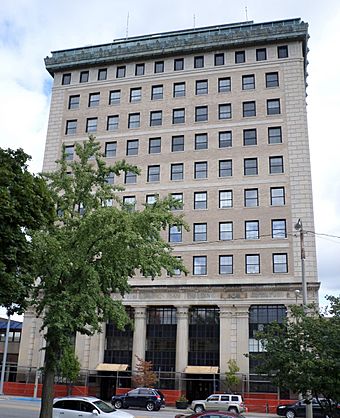Northbank Center facts for kids
Quick facts for kids |
|
|
Industrial Savings Bank Building
|
|
 |
|
| Location | 432 N. Saginaw St., Flint, Michigan |
|---|---|
| Area | less than one acre |
| Built | 1922 |
| Built by | Realty Construction Co. of Flint |
| Architect | Davis, McGrath and Kieslin |
| Architectural style | Renaissance Revival |
| NRHP reference No. | 84001393 |
| Added to NRHP | April 19, 1984 |
The Northbank Center, once known as the Industrial Savings Bank Building, is an important building in Flint, Michigan. You can find it at 432 North Saginaw Street. Today, it is part of the University of Michigan–Flint campus. This historic building was added to the National Register of Historic Places in 1984. This means it is a special place worth protecting.
Contents
The Bank's Early Days
The Industrial Savings Bank started in 1909. It helped business owners and factory workers in Flint. During the early 1900s, Flint was growing fast. This was a time of "economic boom," meaning lots of jobs and money.
The bank grew quickly too, serving people all over the city. By 1913, the bank needed a bigger space. They opened a new building but kept their first location. This made them the first bank in Flint with more than one office. Soon, they had six offices!
By 1922, the bank needed to expand again. They hired a famous New York architecture company called Davis, McGrath and Kiesling. Construction began in 1922 and the building was finished in 1923.
Life in the Building
This new building was the main office for the Industrial Savings Bank. It also housed the Industrial Mutual Association. This group was a "benefit society," which means it helped people in Flint with things like health or money.
The bank did very well in the 1920s. In 1929, it joined with another bank, the Union Trust and Savings Bank. The new bank was called the Union Industrial Trust and Savings Bank. They even started building a new, larger headquarters.
However, the Great Depression hit in the 1930s. This was a time when many people lost their jobs and money. Like many banks, the Union Industrial Trust and Savings Bank faced big problems. It closed for good in 1933.
New Owners and Uses
After the bank closed, the building was put into "receivership." This means a special person or group took control of its assets. They tried to sell the building for many years.
Finally, in 1943, a group called the Greater Flint Industrial Union Council bought it. They used it for offices for local groups of the Congress of Industrial Organizations. This was a big organization that helped factory workers.
The building wasn't used much, so it was sold again in 1948. For the next few decades, it was home to many different businesses. Doctors, lawyers, and government offices all used the space.
The Northbank Center Today
In 1997, the University of Michigan–Flint decided to buy the building. By then, it was known as the Northbank Center. The university fixed up the building in 2000.
Today, the Northbank Center is a busy part of the university. It has dance studios, university offices, and community offices. There's even a place that helps new small businesses get started. The building also has a large room called the Grand Ballroom, which is used for events.
Building Design
The Northbank Center is a twelve-story building shaped like the letter "L." It is a great example of Renaissance Revival style. This style looks back to classic Roman and Greek designs.
The first three floors form the base of the building. They have tall, decorated columns called "pilasters" made of limestone. The spaces between these columns have rough-looking granite and many windows. Above these floors is a decorative band with the bank's name and founding dates.
The next seven floors are made of brick. They have many windows and limestone bands every two floors. The corners of the building have decorative stone blocks called "quoins."
The top two floors are a bit different. The eleventh floor has twelve windows and limestone panels. Above this is a decorative edge. The twelfth floor is set back from the street. This creates a rooftop terrace. This top floor has a stucco finish and a decorative railing.
The side of the building is similar to the front. However, it doesn't have the paired columns on the ground floor. The twelfth floor is also set back only at the corners.

